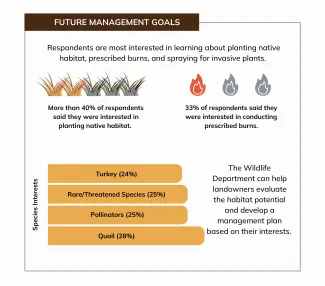Private landowners have long been recognized as the most influential habitat managers in Oklahoma. Combined, they own more than 95% of the state’s land, making Oklahoma a Top 10 majority privately-owned state, and can make the biggest impact on our state’s fish and wildlife communities.
Because these landowners are valuable partners in habitat management, the Wildlife Department’s private lands and human dimensions teams partnered to deliver a survey that gauged landowner interest in managing for wildlife habitat and found out what practices are being utilized across the state.
“We were able to reach out to a variety of landowners, including many that weren’t our agency’s typical hunting or fishing customer,” said Josh Richardson, private lands supervisor for the Wildlife Department.
The 45-question survey was sent to about 14,000 people in the spring of 2021. More than 1,500 private landowners responded, sharing information about their land uses, management practices, involvement in conservation programs, and fish and wildlife species they’re interested in managing for in the future.
Creating a Landowner Baseline
Though the Wildlife Department’s private lands team meets with hundreds of landowners each year, this was one of the first times the Wildlife Department surveyed a large number of private landowners to learn about their current management strategies.
“The survey helped reaffirm the average Oklahoma landowner is a familiar face. Most survey respondents live on their property in a rural area, and most own 80 acres or less,” said Richardson.
“Some of the most exciting results were the number of people interested in doing something for wildlife on their property, and that a vast majority of landowners consider the benefits and impacts to wildlife when making management decisions.”
“Since this is our first survey about how wildlife habitat is being managed on private lands, the results give us an important starting reference point, or baseline, about the landowners we serve,” said Betsey York, human dimensions specialist. “These survey results give us a better understanding of what landowners may need from the Wildlife Department to better manage habitat on their properties and may shape future programs or outreach efforts.”
Get more survey results in the final report.

Connecting Landowners with Habitat Improvement Resources

Another encouraging survey result was the number of respondents actively managing their property for wildlife. More than 45% of respondents reported they were already providing specific habitat types. And respondents were most interested in providing habitat for quail, pollinators, and rare or threatened species in the future. Management efforts for these “umbrella species” often trickle down to other wildlife that share similar habitat needs.
Survey respondents also showed a strong interest in learning about beneficial practices like planting native habitat, conducting prescribed burns, and spraying for invasive plants.
“That’s where we come in,” said Kyle Johnson, senior private lands biologist. “We share techniques and tips for improving habitat in our quarterly e-newsletter, ‘Your Side of the Fence.’ And our team regularly schedules free visits with private landowners on their properties to talk about their wildlife goals, develop realistic management plans based on the available resources and needs, and potentially help with some of the habitat improvement costs.
“We know wildlife habitat doesn’t always look the same to landowners and biologists, but our private lands team can help bridge the gap between a property that is ‘cleaned up’ or ‘looks good,’ and one that provides quality habitat for fish and wildlife,” Johnson said. “We can help identify areas that are best left unmowed to maintain nesting or protective cover. We can also identify the native ‘weeds’ and plants that will provide most wildlife the bulk of their food.”
Though the survey has wrapped, the Wildlife Department still welcomes feedback from landowners and other constituents.
“We want to hear from you,” Richardson said. “Especially if you’re interested in creating or maintaining wildlife habitat on your property. Technical assistance is available, and we can help create a management plan or find ways to add wildlife touches to your property.”
Share your thoughts and ask for technical assistance at wildlifedepartment.com